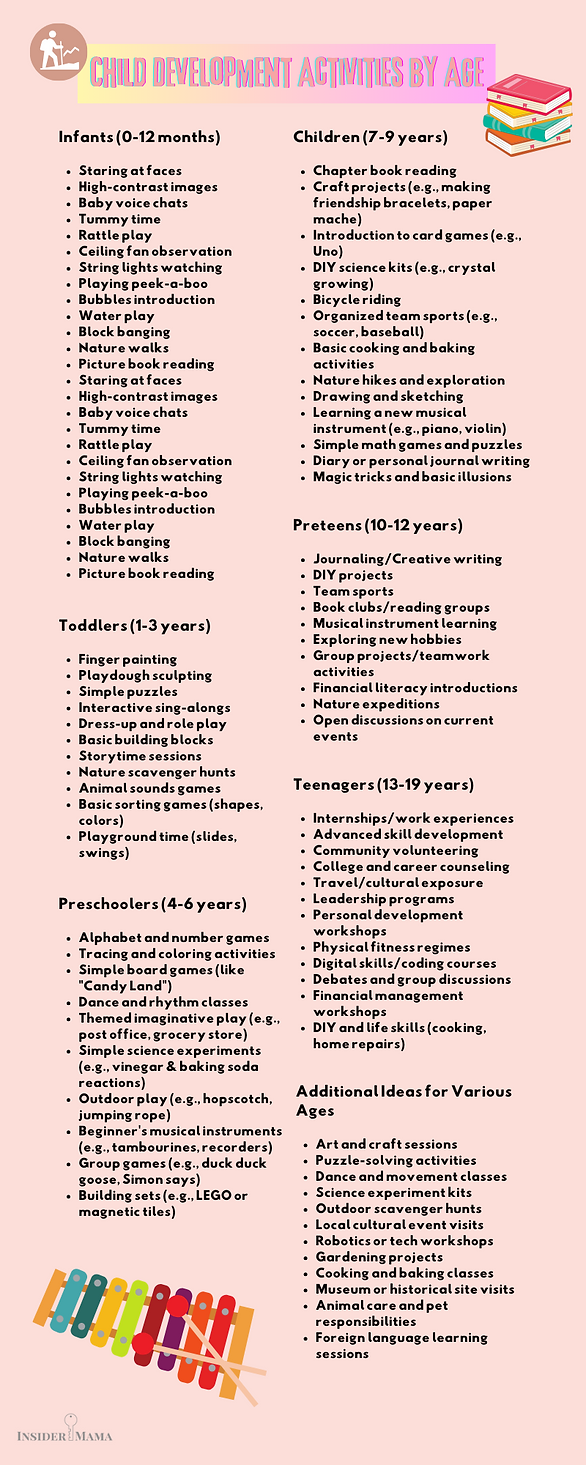We all know that little humans are like sponges, right? And I’m not just talking about their uncanny ability to spill liquids everywhere and somehow soak it all up with their clothes. (Seriously, how do they do that?) I mean, our kids absorb and learn so much, so fast. Just like how we’ve mastered cleaning those spills with a smile on our faces, we also need to ensure they’re soaking up the right stuff developmentally. This post is going to outline child development activities by age for you.

This site contains affiliate links; please view the disclosure for more information.
Child Development Activities by Age (0-19)
Welcome to the world of squishy cheeks, tiny toes, and countless diaper changes! Infancy, that incredible period from birth to one year, is filled with rapid growth, beautiful milestones, and, as any seasoned parent will tell you, LOTS of “Is this normal?” moments.
0–3 Months: Child Development Activities by Age
Newborns in this age range are just beginning to make sense of the world around them. Their adorable little brains are like soft sponges, ready to soak up everything. Here are some activities you can introduce:
- Staring at your face: Yep, just your face. It’s fascinating to them, so get used to being a superstar in those tiny eyes!
- High-contrast images: Think bold black-and-white pictures. They’re not only artsy but also catch the attention of your infant’s developing vision.
- Chit-Chat: Using a high-pitched baby voice might seem a bit odd to adults (and, okay, slightly annoying to some), but for your baby, it’s super engaging. So go on, channel that inner diva voice!
- Floor Time: Spend some time with your baby on the floor. It gives them a different view of their world. And when you feel brave, introduce…
- Tummy Time: This activity comes highly recommended by experts to help your baby build those essential muscles. Remember, in the beginning, a minute or two might be all they can handle, but every bit counts!
By around 2 months, watch out for that first social smile. It’s pure magic and worth every sleepless night.
4–8 Months: Child Development Activities by Age
Now, things are getting exciting! Babies become more aware of their surroundings and even their own body parts.
- Discovering Hands: Introduce toys like rattles or soft spoons. You’ll often find them staring at their hands in sheer wonder.
- Lights and Fans: A simple string light can be a source of fascination. But make sure they’re out of reach!
- Floor Activities: From peek-a-boo to introducing bubbles, this age is all about exploring textures and sounds. And yes, everything will end up in their mouth, so keep a watchful eye!
If you want, introduce some baby sign language. This can pave the way for early communication, and there’s something truly awe-inspiring about a baby telling you they want “more” cuddles.
9–12 Months: Child Development Activities by Age
Brace yourself! Your little one is becoming more mobile and might soon be on the move, crawling, or even taking those wobbly first steps.
- Texture Time: Let them play on different surfaces, like grass or soft carpet. It’s a sensory delight for those tiny toes and fingers.
- Playground Adventures: Introduce them to the joys of a bucket swing. The glee on their faces? Worth capturing in a photo!
- Mirror, Mirror: Babies love making faces in the mirror. From surprise to joy, it’s a mini theater show!
- Kitchen Band: Hand them some kitchen utensils, pots, or pans and let them create some music (or noise, depending on your perspective!).
- Move to the Beat: Nursery rhymes that involve clapping, dancing, or simple actions are perfect for this age.
Don’t forget, babies this age might start to experience some separation anxiety. It’s all a part of understanding object permanence. So, reassure them often with your presence and voice. A simple peek-a-boo game can be a great lesson in “I’m still here, even if you can’t see me!”
Toddlers (1-3 years): Child Development Activities by Age
- Stack ‘Em Up: Give them blocks. They’ll stack them, knock them down, and repeat. This is not only hilarious to watch but also fantastic for hand-eye coordination.
- Play Dough Fun: Yes, it might end up in their hair, on their clothes, or occasionally in their mouths, but play dough is great for improving their fine motor skills. Just make sure you’re using non-toxic ones!
- Dance Parties: Throw on some tunes and shake it! This is where your “mom dance” can shine. Dancing helps with physical development and balance. Plus, who can resist a toddler’s dance moves?
Preschoolers (3-5 years): Child Development Activities by Age
- Scavenger Hunts: Make a list of things for them to find around the house or yard. Not only is this like a mini-adventure for them, but it also improves their observation and cognitive skills. “Have you seen the red sock?” might just take on a whole new meaning.
- Pretend Play: Whether they’re a dragon, a chef, or a space explorer today, pretend play fosters creativity and imagination. So, next time they serve you “soup” made of LEGO, make sure to compliment the chef!
- Simple Board Games: Games like “Candy Land” or “Chutes and Ladders” are not just fun but also teach taking turns and counting.
Early School Age (5-7 years)
- Nature Walks: Kids at this age are natural scientists. Go on nature walks and let them explore. They can collect leaves, stones, or pinecones and learn about the world around them. You might learn a thing or two as well!
- Reading Together: By now, some kids might start to read simple books. Even if they aren’t reading yet, continue reading to them. It improves vocabulary and listening skills. And those few moments when they cuddle close? Priceless.
- Craft Projects: Let’s get messy! Paint, glue, or glitter (if you’re brave). Crafting helps fine-tune motor skills and allows them to express themselves. Just remember, it’s more about the process and less about the end product.
Middle Childhood (8–10 years)
- Cooking Together: Simple recipes can teach them about measurements, patience, and the joy of creating something. And if you end up with cookies at the end of it, well, that’s just a sweet bonus!
- Building Kits: Think Lego sets, model cars, or even simple DIY projects. These kits improve concentration, patience, and problem-solving skills. Plus, it’s a great bonding activity.
- Group Sports or Activities: Whether it’s soccer, ballet, or chess club, group activities teach teamwork, discipline, and perseverance. They might not become the next Messi, but they’ll sure have fun trying!

Preteens (10–12 years)
The time when your child is not quite a teenager but definitely no longer a “little kid”. They’re starting to seek more independence, and their interests are expanding. The activities for this age group focus on boosting cognitive, social, and emotional development while also allowing room for physical growth and creativity. Let’s jump into the world of preteens and discover some engaging child development activities by age!
Journaling and Creative Writing
This is a golden age to introduce the joys of journaling or creative writing. It doesn’t just help with language skills but also provides an outlet for them to express their feelings, which, as we all know, can be a rollercoaster during these years.
DIY Projects
Whether it’s creating their own jewelry, building a model, or starting a scrapbooking project, DIY activities can be both fun and enriching. They allow preteens to follow instructions, be patient, and take pride in their creations.
Sports and Physical Activities
If they haven’t found a favorite sport or physical activity yet, now might be the time. It can be anything from traditional team sports, like soccer or basketball, to activities like skateboarding, dance, or martial arts. These activities teach discipline, teamwork, and perseverance.
Book Clubs or Reading Groups
Reading is fantastic, but discussing a book can add a whole new layer of understanding. Starting or joining a book club can foster both a love for reading and critical thinking skills.
Learning a Musical Instrument
This is a great age to dive into learning an instrument, be it the guitar, piano, drums, or even the ukulele. Music not only boosts cognitive development but also patience, discipline, and creativity.
Exploring New Hobbies
Encourage your preteen to try something new, perhaps something outside of their comfort zone. It could be photography, coding, gardening, or even bird watching. It’s all about exploration and finding their passion.
Group Projects and Teamwork Activities
As they prepare for their teenage years and high school, working in groups becomes important. Engaging in group projects or teamwork activities (think science projects, community service, or group presentations) can help them understand collaboration, leadership, and effective communication.
Financial Literacy Activities
Introduce them to basic money management concepts. Whether it’s giving them a weekly allowance to manage, teaching them about savings and budgets, or even starting a small entrepreneurial project like a lemonade stand, these activities will set the foundation for financial literacy.
Nature Expeditions
Go beyond simple nature walks. Think camping trips, mountain hiking, or even stargazing nights. These activities not only foster a love for nature but also teach survival skills and respect for the environment.
Open Conversations and Discussions
Encourage open dialogue about current events, moral dilemmas, or even movies and TV shows. It’s an age where they start forming their own opinions, and such discussions can guide critical thinking and empathy.
Remember that these years are filled with changes – physically, emotionally, and mentally. The activities you introduce now can shape their teenage years and beyond. Always keep the channels of communication open, provide a safe space for them to express themselves, and most importantly, enjoy this phase before they officially enter the tumultuous, exciting world of adolescence.
Teenagers (13-19 years)
Hello to the world of teenagers, where life is a blend of intense emotions, expanding horizons, and seeking identity! Significant physical, cognitive, and social changes occur during the teenage years, which are a transformative time. Let’s explore some child development activities by age that cater specifically to this dynamic and essential phase.
Internships and Work Experience
Encourage your teen to seek internships or part-time jobs related to their interests. This not only offers practical experience but also teaches responsibility, time management, and introduces them to the professional world.
Advanced Skill Development
If they have a passion or hobby, now is the time to take it to the next level. Be it music, sports, or arts – enroll them in advanced courses or workshops to hone their skills.
Volunteering
Engaging in community service projects or volunteering can provide invaluable life lessons. It fosters empathy, broadens perspectives, and instills a sense of social responsibility.
College and Career Counseling
This is a pivotal time when career choices start taking shape. Regular sessions with a counselor can guide them in making informed decisions about higher education and career paths.
Travel and Cultural Exposure
Whether it’s a school trip, family vacation, or exchange program, traveling exposes teens to different cultures and ways of life, enriching their worldview.
Leadership Programs
Encourage participation in student councils, leadership camps, or any platform where they can take charge, lead teams, and develop leadership qualities.
Personal Development Workshops
Workshops that focus on public speaking, personality development, or even stress management can be extremely beneficial in these formative years.
Physical Fitness Regime
Staying active is important, especially with today’s digital distractions. Whether it’s joining a local gym, taking yoga classes, or just regular jogging, physical activity will boost both health and mood.
Digital Skills and Coding
With the ever-evolving digital landscape, learning to code or enhance digital literacy is an asset. Numerous online platforms and courses can introduce them to the world of programming, digital marketing, or graphic design.
Engage in Debates and Discussions
Debating clubs or platforms where they can discuss global issues, politics, or philosophy can be incredibly stimulating for cognitive development and critical thinking.
Financial Management Workshops
As they approach adulthood, understanding finances becomes essential. Workshops or courses on budgeting, investing, or just basic money management can be truly empowering.
DIY and Life Skills
From cooking to basic home repairs, mastering these essential life skills will not only boost their confidence but also prepare them for independent living.
Exploration, asserting one’s independence, and identity formation are frequently hallmarks of the teenage years. It’s a delicate balance of providing guidance while also allowing them the freedom to discover themselves. Always be there as a supportive pillar, be open to communication, and remember – while they might act all grown-up, they’ll occasionally need that parental cocoon. Cherish these years; they’re fleeting but form the bedrock for the adults they will become.

Tailoring child development activities by age is more than just a way to pass the time; the activities we engage our kids in become the building blocks of their personalities and abilities. So take the time to find the activities that best suit your child’s age and interests, and don’t forget to have a little fun yourself—you’re never too old to play peek-a-boo or master the art of DIY!
The Role of Activities in Child Development
When we think about child development, we often focus on milestones like walking, talking, and learning to read. However, the activities children engage in play a significant role in reaching these milestones and fostering overall growth. Let’s dive deeper into how activities are intertwined with child development and why they are so important.
Nurturing Physical Development
Physical activities are key to developing motor skills. For infants, simple actions like reaching for a toy or crawling strengthen muscle coordination. As children grow, activities like jumping, running, or playing sports refine their gross motor skills, enhance their balance and coordination, and support overall physical health.
Boosting Cognitive Growth
Cognitive development is about how children think, explore, and figure things out. It involves learning to problem-solve, memorize, and use logic. Puzzles, building blocks, and memory games are great for younger children, helping them to develop these important skills. For older kids, activities like chess, science experiments, and strategic games challenge their cognitive skills further, promoting critical thinking and problem-solving abilities.
Enhancing Language and Communication
Activities that involve singing, reading, and storytelling are instrumental in developing language skills. For toddlers, nursery rhymes and simple songs help them learn new words and understand language rhythms. As children grow, engaging in discussions, reading more complex books, and participating in activities like debate clubs can significantly enhance their vocabulary, articulation, and overall communication skills.
Fostering Emotional and Social Development
Activities that involve group play, teamwork, or even solitary creative pursuits like drawing or writing can significantly impact a child’s emotional and social development. Group activities teach children about cooperation, sharing, and understanding others’ emotions. Individual creative activities provide a channel for self-expression and emotional exploration, helping children understand and express their feelings better.
Encouraging Creativity and Imagination
Creative activities like arts and crafts, imaginative play, and storytelling encourage children to use their imagination. This is not just about having fun; it’s about developing the ability to think creatively, solve problems innovatively, and view the world from multiple perspectives.
Instilling Lifelong Learning Habits
Finally, activities that are both educational and enjoyable can instill a love for learning in children. When children find joy in learning, they are more likely to become lifelong learners, always curious, and eager to acquire new knowledge and skills.
Final Thoughts
In summary, activities play a multifaceted role in child development, impacting physical, cognitive, emotional, social, and creative growth. Choosing the right activities for each age group is not just about keeping children occupied; it’s about providing them with the tools they need to develop into well-rounded individuals. Remember, each child is unique, and finding the right balance of activities that cater to their individual needs and interests is key to supporting their developmental journey.



